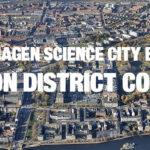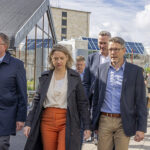Urban renewal project aims to renew North-Western part of Copenhagen Science City
The Haraldsgade area at the north-western corner of Copenhagen Science City is poorer and less educated than most Copenhagen neighbourhoods. With a series of urban renewal projects, the City of Copenhagen now aims to create a safer and greener neighbourhood with a stronger sense of community, a better educated population, and a stronger connection to the surrounding city. By Jes Andersen.
From obsolete industry to knowledge laboratory
Copenhagen Science City is home to some of Europe’s finest institutions of research and education. More than 450 deep-tech start-ups grace the innovation district and companies here attract hundreds of millions of Euro in investments. Yet residents in the Haraldsgade quarter, are less educated and poorer than residents in surrounding areas. On December 16th. 2021 the city council of Copenhagen approved 105 million DKK worth of urban renewal projects with an aim to change that. For the innovation district this is good news.
In Copenhagen Science City we work to make the Haraldsgade area a “knowledge laboratory” by 2025. As a part of this work, we created an action plan outlining initiatives to make the area more attractive and accessible for residents, students, start-up employees and researchers. We look forward to collaborating with the City of Copenhagen and the stakeholders in the Haraldsgade Area to create a better future for the area”: Kristoffer Klebak, Head of Secretariat, Copenhagen Science City.
Activating students to boost public health
The Haraldsgade neighbourhood is an area bordered by the districts Nørrebro, Bispebjerg and Østerbro. It is home to almost 10,000 inhabitants sharing 5,213 homes on an area of just 0,8 square kilometres. It is also home to a campus where University College Copenhagen trains midwives, nurses and technical and scientific staff for the health and care sector. At the University College, they are especially concerned that lifespan and health status in the area is inferior to the rest of Copenhagen.
We welcome this initiative from the City of Copenhagen, and we have entered a formal partnership with the City to improve health and welfare in the quarter. We have 7,000 health- and care students and we see huge potential in letting them collaborate with locals to create health promoting initiatives and train their skills with local citizens”: Kirsten Falk, Head of House of Practice and Innovation, University College Copenhagen. UCC representative in the steering committee for the Urban Renewal project.
Heavy industry replaced by deep-tech start-ups
Until the 1960’s the Haraldsgade neighbourhood was home to some of the largest industrial employers in Copenhagen, including the electrical appliances company “Titan” which employed 4,000 workers in its heyday. Today the quarter is characterized by a mix of residential buildings, educational institutions, older factories transformed to house creative industries and increasingly its office buildings house deeptech start-ups and scale-ups.
Excellent transport infrastructure attracts investors and developers
In 2019 the City of Copenhagen inaugurated the Skjolds Plads station on its Metro Circle line. The station and its refurbished surroundings have already made a substantial difference. Several public and private investors have plans in the neighbourhood
Four themes for urban renewal
Until 2026, the quarter will see some 16 urban renewal projects ordered under the four themes; connectivity, greening, culture and education. The projects include:
- Copenhagen has a 10-kilometre bicycle route “Den Grønne Sti” (The green path). It starts in Valby and ends rather abruptly at the eastern border of the Haraldsgade quarter. Prolonging this route from Tagensvej to Vibenshus Runddel will make it more useful. [6,6 mio dkk]
- Road safety projects at either end of the district should make it easier for soft road users to find their bearings when they enter the area. At one end, where Tagensvej crosses Haraldsgade near the new Metro station, and at the other end where Sigurdsgade enters Sifs Plads near the University College Copenhagen campus. This project should make the area feel safer to pass and more pleasant to stay in. [8 mio dkk]
- Because of its industrial past, the neighbourhood has fewer parks and less greenery than other Copenhagen quarters. A number of local streets are scheduled to become part of Copenhagen’s’ safeguards against extreme cloudbursts. This project, combining climate adaptation measures with narrower streets and larger patches of green, should also contribute towards safer roads. [9 mio dkk]
- Lersø Park Allé. One of the few green streets today, Lersø Park Allé, is also a major traffic artery with a four-lane road restricting access to the two broad swaths of green lining the road. This project aims to restrict road access to motorized transport and increase pedestrian access. [4,5 mio dkk]
- The Haraldsgade area houses two fine venues for art and culture. Unfortunately, very few people, even locals, know about them. The Osram House is a community centre housed in an architectural gem of a 1950’s industrial building. The KTK-lot is an industrial compound where all buildings are rented to socioeconomic companies and artists. This project aims to increase networking, support events at the two venues and open them up to the surrounding city. [4,6 mio dkk]
- 40,000 people work or study in health and science related institutions and the area in and near the Haraldsgade quarter is home to over 450 deeptech companies. Yet the inhabitants in the area are less educated than the rest of the city. 63,7 percent have only an elementary school education. This project aims to lift education levels in the area. [4,3 mio dkk]
City of Copenhagen Urban Renewal Plan (In Danish)
Copenhagen Science City vision for Haraldsgade quarter (In Danish)




